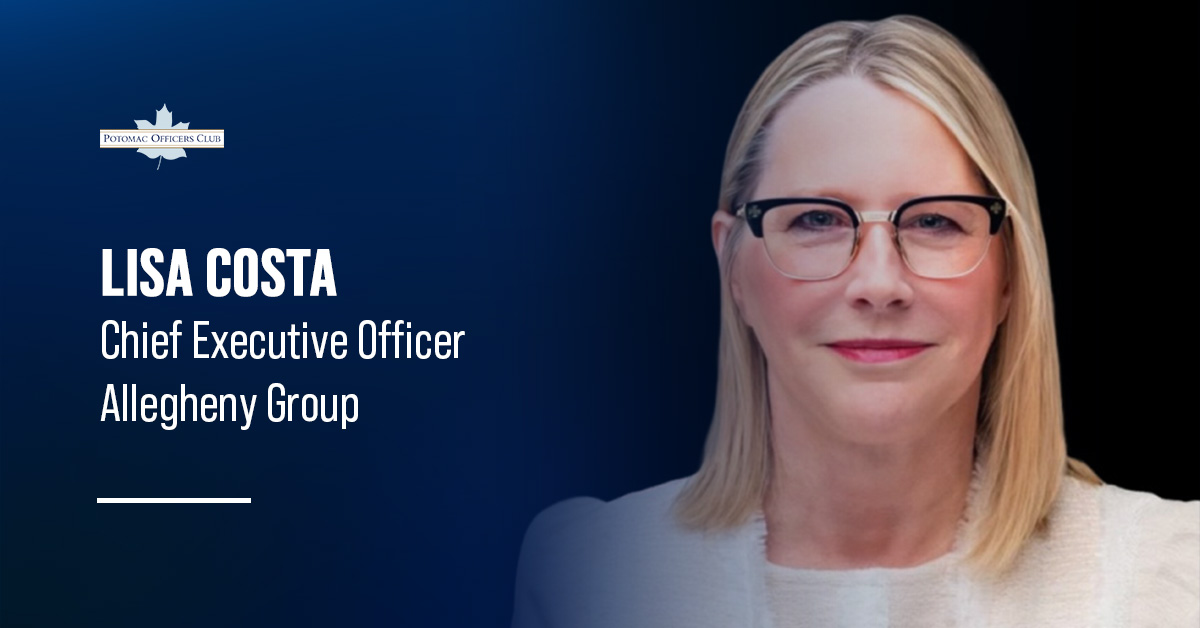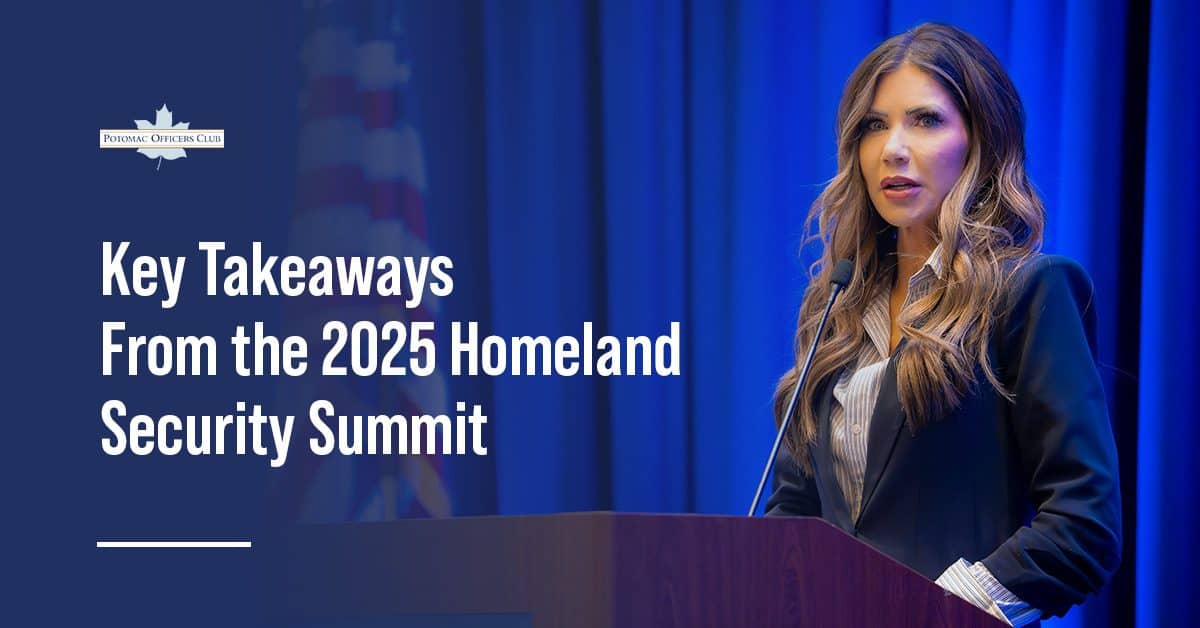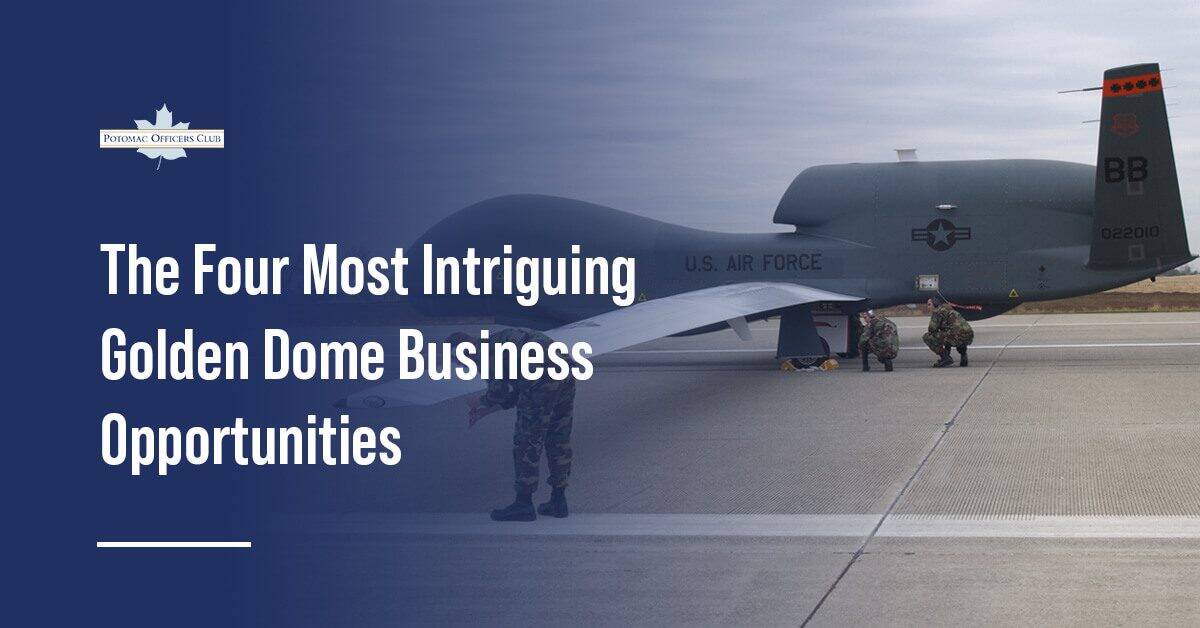
Former Space Force CTIO Lisa Costa on Her Transition to Industry, Today’s GovCon Market & More
Lisa Costa is a major player in U.S. space defense and in national security, helping to shape how the U.S. utilizes innovative technologies to power its military ecosystem. Hers has been a hugely noteworthy and celebration-worthy Senior Executive Service career: 25 years at MITRE in a series of roles of escalating importance, then serving as chief information officer at U.S. Special Operations Command and finally rounding out her public service as chief technology and innovation officer at U.S. Space Force. She was recognized with the Wash100 Award in 2022 for her achievements and impact on the GovCon sector.
Costa is now in the private sector, serving as CEO of her own consultancy, Allegheny Group, and exercising her venture capital muscle as a partner at Squadra Ventures. She will be speaking at the Potomac Officers Club’s 2025 Air and Space Summit on July 31 on a panel about emerging tech can enable “the new space race.” Register for this GovCon networking conference now!
We convened with Costa ahead of her panel appearance to see how her transition back to industry has been going and to get her take on the changing GovCon market. She also shared the three main technologies that are most transformative in the space sector right now.
Potomac Officers Club: Talk to me a bit about your transition from Space Force to industry. How has it been going and what have you learned?
Costa: Going back into industry, I’ve found it’s a very different environment from when I left. The defense space is much more dynamic now. There’s significantly more venture capital and private equity investment flowing into defense firms, which I’m really excited to see—especially because so much of the technology is dual use. So why should the government or industry pay twice as much for products that can serve both markets?
I’m also encouraged that private equity and venture capital haven’t turned away from the federal space despite the time delays that are often part of doing business with the government. At the same time, I’m glad we’re actively working to reduce those delays.
I think it’s also smart that Golden Dome will be operating under OTAs and other flexible acquisition authorities. That’s a step in the right direction.
POC: What’s your take on the shifting contracting landscape right now and how those in the GovCon sector, either exiting government or currently within industry, should react?
Costa: I think a lot of people are understandably upset. The federal workforce has traditionally made a trade-off—accepting lower pay in exchange for job security. And yes, a lot of people were let go recently and I get why there’s frustration.
That said, I think some may be missing the forest for the trees. If you look at LinkedIn and other job boards, defense companies are hiring aggressively. They often offer higher salaries, and in some cases, better benefits. I see this as an opportunity, especially for those who have only worked in government. It’s a chance to transition into industry, experience a different environment, and maybe even appreciate that while there’s bureaucracy everywhere, it’s not quite like what exists in federal agencies.
For those who make the leap, they can always return to government down the line if they choose. In the meantime, this shift could lead to a leaner federal workforce that relies more on contracted capability—and a broader, more diverse contractor base. That includes non-traditional players, small businesses, VC-backed startups and of course, the large primes and tech companies like Blue Origin or AWS. There’s no reason we should be buying bespoke solutions for capabilities that already exist commercially—except that we’ve always done it that way.
I think commercial buying, expanding the experience base and enabling more of the workforce to directly engage with technology are all smart directions. We need to democratize access to tools and information. There’s no reason an agency should have 200 people just tweaking dashboards because leadership metrics change week to week. With today’s tools, especially AI, leaders should be able to adjust their own dashboards and empower their teams to do the same.
We should be enabling people to “vibe code,” so to speak—to build and adapt tools quickly without waiting years for a contract or formal accreditation. If a process is already accredited, we shouldn’t have to re-accredit every small output of that system. Once the technical system and its development pipeline are trusted, new tools should be deployable immediately.
There’s a lot of focus right now on automating basic business systems, which is a good start—but that’s still the “crawl” phase. I’m always a big fan of crawl, walk, run. The goal should be to use software to turn commodity hardware into whatever capability you need.
One of the best examples is ATAK—the Android Tactical Assault Kit from SOCOM. It runs on a standard Android phone, and that device can become an unattended ground sensor, a video source, a translator, even a missile threat warning system. That’s exactly the model we need—flexible, software-driven systems built on commercial platforms that can be rapidly adapted for mission needs.
POC: The panel you’re participating in at the Air and Space Summit is called “The New Space Race: Can Technology Outpace Emerging Threats?” What technologies do you believe are going to be most transformative in the space domain over the next five years and why?
Costa: I believe the future in space hinges on three core things: AI, next-generation energy and power systems, and asymmetry—particularly in cost and time. That last one isn’t a technology itself, but it’s a direct outcome of the first two.
When people think about AI, they often think only of large language models. But AI is much broader. I was working with AI 30 years ago—taking things like the FBI Behavioral Analysis Unit’s paper-based methods and turning them into algorithms that could process big data. What we need now is AI that can move faster than human decision-making, especially in time-critical scenarios.
Take hypersonic weapons. A human simply can’t track and respond to a hypersonic missile in time—not unless you intercept before launch. So we have to develop AI that’s both trusted and governed by clear rules of engagement. That’s the only viable way forward. Golden Dome will absolutely benefit from this kind of AI—recognizing threats faster than any human could and issuing alerts immediately. Right now, our missile warning systems are outdated. We should be able to receive alerts as fast as we get a tornado warning on our phones. Ideally, the system would act preemptively, neutralizing the threat—preferably over open water rather than populated areas.
The 2025 Air and Space Summit on July 31 will feature an all-industry panel discussion about Golden Dome with representatives from RTX, L3Harris, Booz Allen and more. The event will also host Golden Dome leader Gen. Michael Guetlein of U.S. Space Force as one of its keynote speakers. Save your spot at this essential GovCon air and space defense summit now!
The second key area is energy. We’re entering a new era where we can achieve smaller, cheaper and more powerful energy sources to support edge-based systems. When I talk about edge computing, I’m talking about Marines literally carrying data centers on their backs—devices smaller than the Alienware laptop on my desk, but packed with GPUs and massive processing power. These systems demand a lot of energy, and I think we’re finally moving past legacy power constraints that held back innovation. Whether it’s forward-operating bases or naval battle groups, we’re starting to see more resilient power solutions—everything from tactical energy packs to portable nuclear power systems. There’s even a wave of startups working on small-scale nuclear reactors, which could be a game-changer for large data centers and field operations alike.
And when you combine advanced AI with next-gen power, you unlock real asymmetry. That means faster response times and smarter cost efficiencies. I don’t want to rely on a $3 million missile to shoot down a $300 threat. The math just doesn’t work. You see it already with drone warfare—expensive systems taking out cheap targets. It’s not sustainable. We need AI to help us pair the right weapon with the right threat, and we need to do it in real time.
That’s the opportunity space: AI and energy converging to fundamentally change how we detect, decide and act—faster, cheaper and more effectively than ever before.
POC: What was your proudest accomplishment as chief technology and innovation officer of Space Force (2021–2024)?
Costa: There are a lot of things I’m proud of, but one that really stands out is the Supra Coder program. What made it different wasn’t just that we were training coders—we were training operators who were already certified on a weapon system. These individuals self-selected into the program, then went through intensive training. The result was a group of people who could make real-time modifications to weapon systems as situations unfolded. That’s exactly what you need in a modern fight.
I can hire a contractor coder any day of the week—but that’s not what this was about. Supra Coders had deep expertise in the systems they worked on. They weren’t just coding; they were shaping how those systems performed in new, unforeseen circumstances. That, to me, is the essence of readiness—being prepared for the next unknown fight.
Coming from a special operations background, that mindset was second nature. But in the Space Force, which had long operated in a more benign environment, it was a newer concept. I think the Supra Coder program helped shift that mindset in a meaningful way.
Now, the disappointment with the program was structural. From the beginning, we told participants this wasn’t a new job code—they could only do two rotations before returning to their original role. But what we saw was people who hated their original military specialty absolutely thriving as Supra Coders. They loved their work. They were energized. You’d have to kick them out of the building at night because they didn’t want to stop working. And then we’d tell them after two tours, “You’re done,” and it was crushing. They thought, “I did great. Why can’t I keep doing this?”
That points to a bigger issue in how the military manages talent. Right now, you take the Armed Services Vocational Aptitude Battery—or ASVAB—you get a score, and we tell you, “You’re going to be a truck driver,” for example. And no matter what skills you pick up over the next 20 years, that’s still your military occupational specialty. That’s not how people work anymore—especially not this generation.
If we want people to stay in for 20 or 25 years, we have to accept that they’re going to master something quickly and then want to move on to the next challenge. That’s not a weakness—it’s a strength. But instead of encouraging that, the system often penalizes it. We need more flexible career pathways in government and military service, because that’s the only way we keep our best talent.
POC: Why should folks be excited about your panel at the Air and Space Summit (and the event broadly)?
Costa: There’s a lot happening in space right now—not just militarily, though that’s certainly a key concern. Our adversaries are actively militarizing space every day. But what excites me is the incredible ecosystem of early-stage companies developing innovative capabilities. As a venture capitalist, I get to see some of the groundbreaking work happening well before it hits the market.
What we need to do is make the barrier between these startups and government programs far more permeable. We have to accelerate the adoption of these capabilities into national security systems. That’s where the real opportunity lies. Yes, we face threats in space, but we also have a thriving innovation pipeline.
And it’s not just small companies—major defense primes like Lockheed Martin and Northrop Grumman have their own venture arms and are actively investing in this next wave of technology. That strengthens both our government-industrial base and the commercial space race.
I’d also highlight the growing interest from international partners. Many nations want to collaborate in space, and the U.S. should be their first partner of choice. For that to happen, the State Department needs to reduce ITAR barriers and make it easier for these companies to work with us—not push them toward China or other competitors. Lowering those barriers is essential if we want to lead globally and ensure our allies are working alongside us in this domain.

Category: Articles





